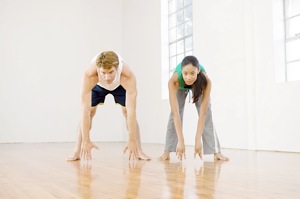-
- Same-sex marriage backers want to open Massachusetts to out-of-state couples
- Ellen DeGeneres wins big at Daytime Emmys
- Dallas chooses Leppert as next mayor
- ABC studio made business calculation in dumping Isaiah Washington from ‘Grey’s Anatomy’
- Navajos continue to battle HIV/AIDS despite cultural taboos
- Testing of people at high risk for AIDS suggested
- National News Briefs
- World News Briefs
health & sports
Fit for Life
The benefits of warming up
Published Thursday, 21-Jun-2007 in issue 1017
I’m particularly fond of one childhood memory: It was when I finally reached that age when my dad felt comfortable allowing me to warm up the car before we took it for a spin. Not quite old enough to drive, I would gladly hop in the driver’s seat to get a small taste of what it would be like to head out on the highway on my own with the wheel responding to every move I made.
Once I got my own car, dad would lecture me on the benefits of warming up the car before use. But, despite his warnings, I would find myself “too busy,” and then my sluggish ’66 VW Bug would chug and backfire down the road until its systems had enough time to function properly. Yes, the car was old and in desperate need of a tune up or two, but what I didn’t realize was that I was learning a valuable lesson that went far beyond carburetors and exhaust pipes.
The human body is much like a car; in that, after sitting for hours on end, it requires necessary preparation time prior to participating in an effective workout. Unfortunately, with today’s hustle and bustle, the warm-up is often neglected and exercisers go right for the guts of the routine. The warm-up, however, is perhaps the most important aspect of the workout because it gets both mind and body prepared for the tasks to be performed. A warm-up can also help improve strength, flexibility and endurance and, when done correctly, will quickly become an asset to your regular program.
Injury prevention
In this column, I regularly focus on injury prevention because, let’s face it, injuries keep you from achieving results, and when left untreated will become an annoyance for the rest of your life. Introducing a warm-up into your regular program is a surefire way to prepare the body for the activities you’re about to participate in. Recent research has found that exercisers who gradually warmed up the body had less incidence of exercise-related injury. The reason for this is because, at the beginning of a workout, the muscles are somewhat “cold” and experience reduced elasticity and contraction. Area blood flow is limited, which prevents the muscle from working to its fullest potential. Lack of blood flow can also increase the risk of significant damage to the muscles, tendons and ligaments, which then places the body under excess stress and can lead to significant pain and injury. Race car drivers give their vehicles time to get the juices flowing before reaching high speeds. Why would you treat your body any differently?
Mental preparedness
Have you ever noticed how athletes prepare for competition? Often you will see a distance runner hopping up and down or taking a short jog before the start whistle is blown. Similarly, baseball players get ready to hit grand slams by taking several practice swings before stepping up to the plate. This is what we would call getting “psyched,” or mentally prepared for the tasks at hand. Within the body are many neural pathways that act as sort of an information highway or message transportation center. These pathways need to be activated so the brain’s instructions can be efficiently and effectively relayed to the necessary musculature for optimal function.
Greater heart function
As you are probably aware, the heart is responsible for providing the body with fresh, oxygenated blood. At the beginning of a workout, the heart rate, or the rate at which blood is pumped through the body, is relatively low. Jumping right into an intense routine shocks the heart and may cause excess strain due to the instant increase in the amount of blood it needs to transport through the body. A steady progression of movements will allow the heart to acclimate to the enhanced workload and limit potentially dangerous stresses. This is especially important for those with high blood pressure or other cardiovascular ailments.
Greater success
Just like my old VW, when the body is allowed to warm up to optimal functional capacity, it will run like a well-oiled machine. All the transmitters are firing, the heart is beating steadily and the muscles are warm and produce quick, effective contractions, which will help you to lift more weight, run faster or hold that pose for a longer period of time. This results in achieving your health and fitness goals in a more time-effective manner.
How to warm up
It is highly recommended that you start by activating the deep core musculature first because all movement originates there. A great way to activate the core is to perform a static bridge (Lie on the back with the knees bent and feet hip-width apart. Slowly lift the hips up toward the ceiling and hold for a short period of time) or plank (the start of the pushup position). Once the core is warm, begin adding movements like a pushup, shallow lunges or squats. Stick with body-weight-only exercises or very light external resistance for the first five to 10 minutes, and then jump right into the meat of the routine.
A warm up can provide a great many benefits including improved performance and injury prevention. Experiment with different types of less-intense exercises and develop a routine that works for you. Implement it into your workout for the next few weeks and see if you notice any difference in your program. You won’t be disappointed. Happy training!
Why not to stretch before working out
While stretching is essential to a holistic and well-rounded exercise program, recent research has provided evidence against stretching prior to working out. Generally considered a great way to improve muscle coordination, enhance range of motion and reduce injury potential, leading experts are now discovering that pre-exercise stretching may cause more harm than good. In physiological terms, stretching a muscle leads to decreased muscular contraction, which can negatively effect exercise performance. Researchers have also found that stretching decreases neuromuscular activation thereby inhibiting the efficiency at which messages are transmitted from the brain to the muscles. Several of these studies have shown that running speed, muscular strength and endurance, and power production are all adversely affected, raising questions as to the validity of pre-exercise stretching. This does not mean that stretching should be completely eliminated from your regular routine. Many research studies indicate significant benefits of stretching when completed at the completion of the exercise routine or competition.
|
|
Copyright © 2003-2025 Uptown Publications




